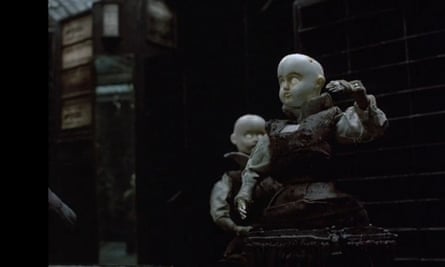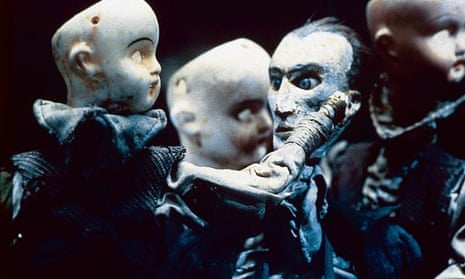“So, on that last one. What was your inspiration?” By the third time the moderator uses this generic, parody-of-a-bad-interview question, one could only smile.
This is no ordinary Q&A. This is a session with a man, usually hammered by fanboy-ish questions, getting a chance to do a little geeking out. Christopher Nolan, director of Memento, The Prestige, Inception, Interstellar and the Dark Knight Trilogy is using some of his considerable industry clout to promote a programme of newly scrubbed-up 35mm short films by stop-motion animators the Brothers Quay. In addition to In Absentia (2000), The Comb (1991) and Street of Crocodiles (1986), the collection includes Quay, an eight-minute mini-documentary of the brothers in their cramped, magical London studio filled with decaying doll parts, screws, wigs chewed by bugs and old cameras. This men-behind-the-curtain peek is directed, shot, edited and scored by Nolan, and is essentially the movie version of a fan winning Wonka’s golden ticket and poking around the factory.
Quay was shot on film (rare for a documentary) and projected in film format (virtually unheard of these days) at its debut at New York’s Film Forum, kicking off an 11-city North American tour. After the four shorts, Nolan is joined at the front of the screening room by the 68-year-old identical twin brothers Timothy and Stephen Quay for a low-key talk light on revelations but heavy on sizeable grins.
The Quays (pronounced kwayz, not keys) wear their hair wild and wavy and their shirt collars open. The Pennsylvania natives have lived in England for decades, giving them an unusual accent that makes them sound even more sealed off from the rest of the world than their job requires. After saying how great it is to see their work projected again on 35mm, their new benefactor comes in with some extremely specific questions about sound design and lighting techniques with a palpable zeal to just get these two men talking about their process.
In Absentia was a BBC commission for a series called Sound on Film. Avant-garde composer Karlheinz Stockhausen recorded a piece of music that the brothers were tasked to incorporate into a 20-minute short. (Other pairings in the series included Nicolas Roeg and Adrian Utley of Portishead, Hal Hartley and Louis Andriessen and Werner Herzog and Sir John Tavener.) Working with Stockhausen was an unusual experience, both brothers recall. Timothy remembers how, in April of that year, Stockhausen told them that the music would arrive on exactly 21 August at precisely noon. Which it did. When the German composer visited their studio to check out an early cut, his only suggestion was that they “add some blue”.
In Absentia was inspired by a gallery exhibit that featured artefacts from a mental asylum, including letters a woman wrote to her husband daily, but did not send. All of the Quays’ films have whiffs of traditional narrative, but the surreal stop-motion, which teeters between the playful and the eerie, tends to evoke more tone than story.
Street of Crocodiles, the film that put the Quays on the map, based on a short story by Bruno Schulz, is a wordless fever dream in which a puppet has his strings snipped and explores an underworld of animated household items such as lightbulb creatures and ghostly illuminated dollheads. While drawing some degree of influence from master Czech animator Jan Švankmajer, Street of Crocodiles was unlike anything else happening in the mid-1980s, and had an enormous impact on everything from design to rock videos when it was released.

In Quay, we get a glimpse at these iconic dollheads, as the brothers show how their look changes in natural light. Their studio – cluttered with lo-fi tools such as bits of glass frosted with laundry soap – features a prominent window around which they place mirrors to angle the rays of the sun. “However, in Britain,” they add, “you never quite get a clear sunny day.”
Indeed, unexpected clouds have long been one of the happy accidents they rely on. So much of their work is intensely detailed and meticulous, which balances nicely with, say, unusual shadings they discover when the film comes back from the lab.
“It’s mathematics,” Timothy confesses when describing just how they craft a lengthy dolly shot. “1mm a shot at 600 frames for 24 seconds … it’s a lot of getting back up and crouching back down,” he jokes. While still spry and in good health, references to aching knees and bad backs are abundant. Yet with the intense film-making process, there’s still the issue of figuring out when a movie is complete. Despite abundant planning on individual shots, they were clueless on how to wrap up Street of Crocodiles. “We were frustrated, so we took a bike ride down to a zoo,” Timothy recalls. “There we saw a lizard. We were looking at him, he was looking at us. It was like a stand off. Then he made this sudden move, like an arm gesture, and we both instinctually knew – that’s how it ends.”
“We don’t really have a script,” Stephen confesses. “If we wrote something like, ‘the screws start spinning out of the wood’, a producer might ask: ‘Why?’” Nolan chuckles before echoing from his own experiences with Hollywood studios. “If I could write it down, I’d make a book, not a movie, right?”
“What we have instead of a script,” Stephen concludes, “is an intelligent bluff, just enough to get the money before we then throw it all away.” The evening’s programme, which just scratches the surface of the Quay Brothers’ work, proves that whatever alchemy they are using, it’s working.
Christopher Nolan’s Quay is released on Blu-ray on 20 October.

Comments (…)
Sign in or create your Guardian account to join the discussion